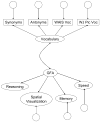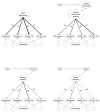Vocabulary test format and differential relations to age
- PMID: 18573010
- PMCID: PMC2518066
- DOI: 10.1037/0882-7974.23.2.366
Vocabulary test format and differential relations to age
Abstract
Although vocabulary tests are generally considered interchangeable, regardless of format, different tests can have different relations to age and to other cognitive abilities. In this study, 4 vocabulary test formats were examined: multiple-choice synonyms, multiple-choice antonyms, produce the definition, and picture identification. Results indicated that, although they form a single coherent vocabulary knowledge factor, the formats have different relations to age. In earlier adulthood, picture identification had the strongest growth, and produce the definition had the weakest. In later adulthood, picture identification had the strongest decline, and multiple-choice synonyms had the least. The formats differed in their relation to other cognitive variables, including reasoning, spatial visualization, memory, and speed. After accounting for the differential relations to other cognitive variables, differences in relation to age were eliminated with the exception of differences for the picture identification test. No theory of the aging of vocabulary knowledge fully explains these findings. These results suggest that using a single indicator of vocabulary may yield incomplete and somewhat misleading results about the aging of vocabulary knowledge.
Figures




Similar articles
-
Changes in naming ability with age.Psychol Aging. 1988 Jun;3(2):173-8. doi: 10.1037//0882-7974.3.2.173. Psychol Aging. 1988. PMID: 3268256
-
The association between age and the frequency of nouns selected for production.Psychol Aging. 2009 Mar;24(1):17-27. doi: 10.1037/a0014579. Psychol Aging. 2009. PMID: 19290734
-
Performance of younger and older adults on tests of word knowledge and word retrieval: independence or interdependence of skills?Am J Speech Lang Pathol. 2014 Feb;23(1):36-45. doi: 10.1044/1058-0360(2013/12-0136). Am J Speech Lang Pathol. 2014. PMID: 23831710
-
Developmental aspects of linguistic and mnestic abilities in normal children.J Clin Exp Neuropsychol. 1989 Aug;11(4):518-28. doi: 10.1080/01688638908400910. J Clin Exp Neuropsychol. 1989. PMID: 2760184
-
Aging and the word frequency effect: a lexical decision investigation.Neuropsychologia. 1989;27(9):1197-203. doi: 10.1016/0028-3932(89)90103-6. Neuropsychologia. 1989. PMID: 2812303
Cited by
-
Resting-state and Vocabulary Tasks Distinctively Inform On Age-Related Differences in the Functional Brain Connectome.Lang Cogn Neurosci. 2019;34(8):949-972. doi: 10.1080/23273798.2019.1608072. Epub 2019 May 10. Lang Cogn Neurosci. 2019. PMID: 31457069 Free PMC article.
-
Do age-related word retrieval difficulties appear (or disappear) in connected speech?Neuropsychol Dev Cogn B Aging Neuropsychol Cogn. 2017 Sep;24(5):508-527. doi: 10.1080/13825585.2016.1226249. Epub 2016 Sep 1. Neuropsychol Dev Cogn B Aging Neuropsychol Cogn. 2017. PMID: 27583986 Free PMC article. Review.
-
Individual differences, aging, and IQ in two-choice tasks.Cogn Psychol. 2010 May;60(3):127-57. doi: 10.1016/j.cogpsych.2009.09.001. Epub 2009 Dec 4. Cogn Psychol. 2010. PMID: 19962693 Free PMC article.
-
The predictors of general knowledge: Data from a Spanish megastudy.Behav Res Methods. 2022 Apr;54(2):898-909. doi: 10.3758/s13428-021-01669-4. Epub 2021 Aug 6. Behav Res Methods. 2022. PMID: 34357543 Free PMC article.
-
Aging deficits in naturalistic speech production and monitoring revealed through reading aloud.Psychol Aging. 2019 Feb;34(1):25-42. doi: 10.1037/pag0000296. Epub 2018 Sep 27. Psychol Aging. 2019. PMID: 30265018 Free PMC article.
References
-
- Alwin DF, McCammon RJ. Aging, cohorts, and verbal ability. Journal of Gerontology: Social Sciences. 2001;56B:S151–S161. - PubMed
-
- Arbuckle JL. Amos (Version 7) (computer software) Spring House, PA: Amos Development Corporation; 2006.
-
- Bennett GK, Seashore HG, Wesman AG. Differential Aptitude Test. San Antonio, TX: The Psychological Corporation; 1997.
-
- Botwinick J, Storandt M. Vocabulary ability in later life. Journal of Genetic Psychology. 1974;125:303–308.
-
- Bowles RP, Grimm KJ, McArdle JJ. A structural factor analysis of vocabulary knowledge and relations to age. Journal of Gerontology: Psychological Sciences. 2005;60:P234–P241. - PubMed

